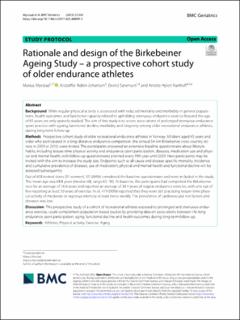| dc.description.abstract | Background
While regular physical activity is associated with reduced mortality and morbidity in general populations, health outcomes and functional capacity related to upholding strenuous endurance exercise beyond the age of 65 years are only sparsely studied. The aim of this study is to assess associations of prolonged strenuous endurance sport practice with ageing, functional decline, morbidity and longevity among older recreational endurance athletes, during long-term follow-up.
Methods
Prospective cohort study of older recreational endurance athletes in Norway. All skiers aged 65 years and older who participated in a long-distance endurance competition, the annual 54-km Birkebeiner cross-country ski race in 2009 or 2010, were invited. The participants answered an extensive baseline questionnaire about lifestyle habits, including leisure-time physical activity and endurance sport participation, diseases, medication use and physical and mental health, with follow-up questionnaires planned every fifth year until 2029. New participants may be invited with the aim to increase the study size. Endpoints such as all-cause and disease-specific mortality, incidence and cumulative prevalence of diseases, use of medication, physical and mental health and functional decline will be assessed subsequently.
Out of 658 invited skiers (51 women), 551(84%) completed the baseline questionnaire and were included in the study. The mean age was 68.8 years (median 68, range 65- 90). At baseline, the participants had completed the Birkebeiner race for an average of 16.6 years and reported an average of 33.4 years of regular endurance exercise, with one out of five reporting at least 50 years of exercise. In all, 479 (90%) reported that they were still practicing leisure-time physical activity of moderate or vigorous intensity at least twice weekly. The prevalence of cardiovascular risk factors and diseases was low.
Discussion
This prospective study of a cohort of recreational athletes exposed to prolonged and strenuous endurance exercise, could complement population-based studies by providing data on associations between life-long endurance sport participation, aging, functional decline and health outcomes during long-term follow-up. | en_US |

